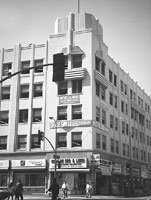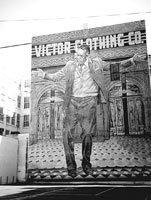Real Estate Deals a Tough Find for Apparel Companies
Apparel sources say they are hearing about a slowing economy but they aren’t seeing it reflected in real estate prices.
The deals that were abundant in 1991 haven’t materialized yet and they may never show up thanks to California’s counter-cyclical economy. It’s still a seller’s market with retail and office space prices holding steady and some bargains to be had in manufacturing and distribution space.
Real estate experts say apparel resources will be relying more on commercial real estate over industrial space going forward as manufacturers continue to downsize their cut-and-sew operations and expand on the designing and retail fronts. Energy concerns and slowing foreign trade are leaving companies in a cautious position, which is slowing real estate development and starting to level off and, in some cases, lower prices.
Trade growth is expected to slow to 3 percent from a robust 16 percent last year, according to the Los Angeles County Economic Development Corp. (LAEDC), which cited a slowing global economy, a strong U.S. dollar and political problems in Asia. Last year, the Los Angeles area apparel industry imported $9.3 billion in goods, up 6 percent. That’s enough to keep demand for real estate strong throughout the Southland.
Housing Hot
The hottest growth segment is coming through housing as developers are capitalizing on strong demand, especially in urban markets like Los Angeles where there is a 280,000-unit housing deficit. The shortage has developers focusing on urban cores for apartments, live/work space and mixed-use projects. This has been a two-fold scenario for the apparel industry, said Jack Kyser, chief economist for the LAEDC, because new housing has been aimed toward Class A high-end product accommodating designers and executive types but not addressing affordable housing, which is needed for laborers and lower-wage employees.
Projects like Medici, a 330-plus unit luxury apartment community in downtown Los Angeles, and several downtown loft conversions are keeping people in downtown after 6 p.m. The addition of the Staples Center and a Disney theater complex under construction, in addition to proposals for a supermarket and specialty retail, are also making downtown more livable.
The successes of these projects are fueling more housing growth. Two companies recently announced plans to convert the Victor Clothing Co. at Broadway and 3rd Street into rentals and eight buildings in the Fashion District into a 780,000-square-foot, 400-unit apartment/mixed-use project, which should bring more retail and live/ work space for apparel industry workers. Downtown San Diego, Pasadena, Long Beach, Sacramento and other areas are being targeted for similar projects.
Retail Slow but Steady
Retailers are scaling back projects throughout the country, but California is holding its own, according to researchers at Colliers International, a Boston-based real estate services company. Population and job growth is fueling retail here with the fastest growth coming from San Diego, Sacramento, Bakersfield and Fresno. Southern California isn’t feeling the after-shocks from the tech industry fallout that Silicon Valley has and it’s evident in retail growth here. More than 12 million square feet of retail space is in the pipeline in Los Angeles County alone, according to brokerage Grubb & Ellis. An averted writers’ strike will save the local economy $507 million per week, according to the LAEDC. Job strength in foreign trade is also one of the forces behind retail’s continued but slowing growth.
The foggy outlook isn’t slowing down planned projects for some. Among them areUri Harkem and Moshe Aflalo, who ownthe Hype and Jonathan Martin brands of apparel and footwear respectively, and are planning Maple Fashion Walk, 30 to 40 men’s wholesale apparel stores planned for Maple Avenue in Los Angeles’ Fashion District, and another 48 units of junior and women’s plus-size apparel stores to be based in the Crocker Mart on the east boundary of the Fashion District. These projects will be aimed at the mass-market consumer. Other retail development projects like Hollywood & Highland will be targeted to an upscale customer.
The high-profile Hollywood & Highland center, a 640,000-square-foot “shoppertainment” destination, hopes to pump life into the Hollywood retail scene by attracting local traffic in addition to tourists. The $615 million center will house 70 specialty shops; a 3,500-seat theater, which will be the site of next year’s Academy Awards; a 640-room hotel; a broadcast center; and office and retail space. The site is also a station for the city’s Metro Red Line subway. Among those signing leases are Tommy Hilfiger, Christian Dior, Hot Topic, Gap and Bebe.The center is expected to open this fall.
The Century City Shopping Center’s new owners, Urban Retail Properties Co., are planning to add a 72,000-square-foot addition, which will include a newly relocated Gelsons market, and more upscale specialty retail. This project should break ground in about a year.
“Century City is a great property,” said Mike Levin of Urban Retail Properties.
“There are loyal customers here and we bought it because we think we can improve it,” Levin said.
Don’t expect to find many deals when it comes to upscale retail space, said Trent Merrill, executive vice president of Lucky Brand Dungarees.
“For premium retail space such as the locations we go after, there always seems to be strong demand,” he said.
Companies Eye Upgrades for Offices/Distribution
Southern California resources Pacific Sunwear, Lucky Brand, Bebe and others are making more long term commitments with office and industrial space but buying into newer constructed buildings that offer better parking ratios, higher clearances for trucks and high-speed data lines for computers and telecommunications equipment. PacSun recently inked a $12.2 million deal to buy a 19-acre parcel near its existing Anaheim headquarters. The new facility will more than triple the retailer’s existing space with 180,000 square feet of office space and 300,000 square feet of distribution space which is enough to service 1,200 stores. PacSun will move in by the end of the year. Bebe recently signed a 12-year lease for 144,000 square feet at the Lincoln Distribution Center in Benicia, Calif., where it will use the facility for office space and receiving, storage and shipping.
Lucky Brand Dungarees is also making the move into bigger and better digs in Vernon. The growing denim producer is set to move into a 140,000-square-foot facility on Alcoa Avenue in Vernon, double the size of its existing facility on District Boulevard.
“Our new [headquarters] has a complete state-of-the-art distribution center, which will streamline our business,” said executive vice president Trent Merrill. The new facility has a 110,000-square-foot warehouse and 30,000 square feet of office space to accommodate 200 employees.
Merrill said he likes Vernon because of its central location and the fact that Vernon has its own power supply, making it less prone to rolling blackouts. While Lucky and PacSun capitalize on growth, the financial woes of companies like Chorus Line and U.S. Spectrum Textile have opened up more than 400,000 square feet of garment industry space in the Vernon area. Industry occupancy rates have been of near highs at 95 to 96 percent, but deals are opening up, according to Pete Reich of CB Richard Ellis, who is leasing the Chorus Line property.
“There’s a little softening and despite the energy problems, there’s strong demand for industry space,” he said. “Rates have been steady but are starting to move down.”
Reich has two Chorus Line buildings of 117,000 square feet and 113,000 square feet respectively for lease at 46 cents per square foot net. He has another 150,000-square-foot building in East Los Angeles for lease at about the same rate.
Smaller buildings south of the Fashion District along the Broadway Avenue corridor are coming available at about 40 cents per square foot. These facilities are smaller, at 5,000 to 10,000 square feet, and are geared for smaller start-ups and manufacturers. Brokers active in this area said they see apparel manufacturers downsizing and subletting some of their space, too.
























